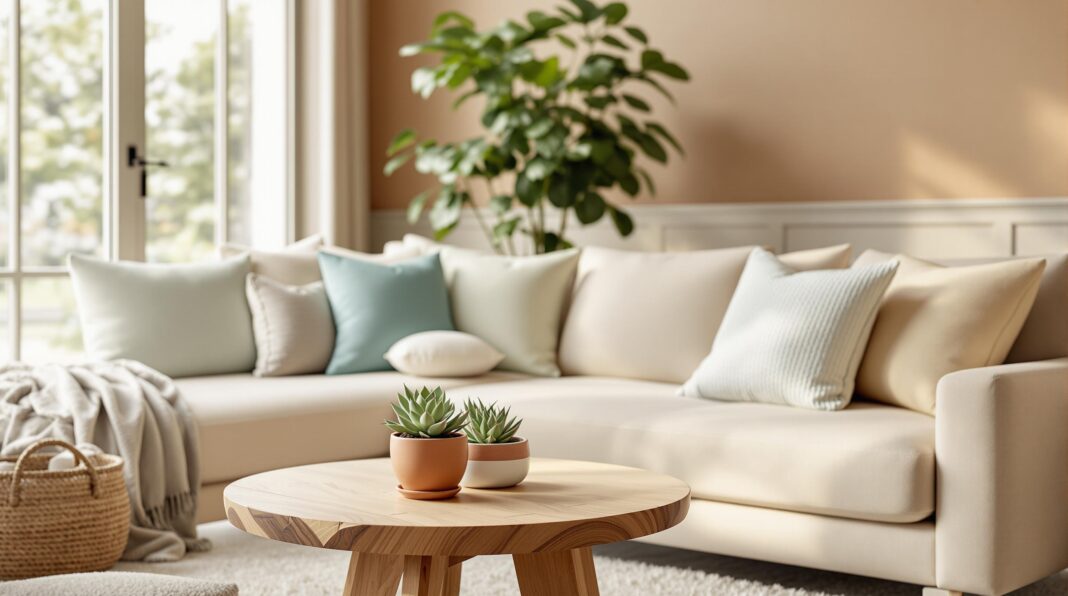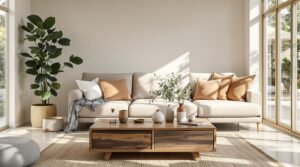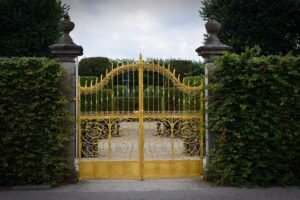Want to bring the outdoors into your home in 2025? Nature-inspired decor is reshaping interiors with calming, eco-friendly designs that promote well-being. Here’s a quick guide to what’s trending:
- Natural Elements: Living walls, raw materials like wood and stone, and indoor gardens.
- Color Schemes: Earth tones, forest greens, and ocean blues for a soothing vibe.
- Eco-Materials: Sustainable options like bamboo, jute, and reclaimed wood.
- Organic Shapes: Curved furniture and patterns inspired by nature’s irregularities.
- Affordable Tips: Add potted plants, botanical prints, or woven rugs for a natural touch.
These trends focus on creating spaces that are stylish, functional, and connected to nature. Whether you’re on a budget or ready to invest, there’s something for everyone. Dive into the full guide to transform your home into a serene, nature-inspired retreat.
Earthy Elegance: Top 2025 Interior Design Trends for a Nature-Inspired Home
Natural Elements for Indoor Spaces
In 2025, homeowners are increasingly bringing nature indoors, creating calming spaces that seamlessly blend the outside world with interior design. Here’s how nature-inspired elements are shaping modern homes.
Plant Walls and Indoor Gardens
Vertical gardens are turning plain walls into lush, green displays. Using modular planter systems, these living walls not only look stunning but also improve indoor air quality. Kitchen herb gardens are also gaining traction, offering fresh ingredients and a lively touch to cooking spaces. For those who prefer low-maintenance options, preserved moss walls provide a stylish alternative. Alongside greenery, raw materials are playing a key role in bringing nature indoors.
Raw Materials in Home Design
Natural textures and tones are making a big impact in 2025 home design. Claire Morgan highlights this trend:
“Drawing inspiration from the natural world will continue to be a major trend in 2025. From botanical prints and nature-inspired decor to the incorporation of raw materials like stone, wood, and leather, nature will be infused into every corner of the home” [5]
From sustainable wood to terracotta, these materials are being used in creative ways:
- Sustainable wood: Found in statement furniture and wall panels, it adds warmth and an eco-conscious touch.
- Natural stone: Perfect for accent walls and countertops, it brings elegance and durability.
- Bamboo: Used in bathrooms and flooring, it creates a serene, spa-like vibe.
- Jute: Adds texture to rugs and wall hangings while staying environmentally friendly.
- Terracotta: Adds Mediterranean charm to planters and decorative tiles.
| Material | Popular Applications | Benefits |
|---|---|---|
| Sustainable Wood | Furniture, wall panels | Warmth, eco-friendly appeal |
| Natural Stone | Accent walls, countertops | Luxury, durability |
| Bamboo | Flooring, bathroom fixtures | Spa-like atmosphere |
| Jute | Rugs, wall hangings | Texture, sustainability |
| Terracotta | Planters, decorative tiles | Mediterranean style |
Curved and Flowing Furniture
Curved furniture is making waves, moving away from the rigid lines of minimalism. Designer Shauna Jones notes:
“I see curved sofas becoming a growing trend in living rooms… I think they spring from the growing trend of organic shapes, live plants, and earthy colors; a reaction to the clean lines and monochromatic aspects of the minimalist trend. They feel more cozy and intimate” [6]
Rounded furniture creates a softer, more inviting atmosphere while enhancing the flow of a room. Designers are incorporating organic shapes into sofas, chairs, and tables, mimicking the curves found in nature. Pairing these pieces with more structured elements can create a balanced and visually interesting space. Even a single curved chair or an organically shaped coffee table can bring a touch of nature’s elegance indoors.
Nature-Based Color Schemes
The 2025 color palette takes its cues from natural landscapes, aiming to bring a sense of calm and connection to our homes. These colors create an inviting atmosphere while reflecting the beauty of the outdoors.
Earth Tones and Neutrals
Warm browns and rich terracottas are gaining attention in 2025. As Sarah Barnard Design puts it:
“Nature-inspired color palettes can help ground us by connecting built environments with the beauty of the outdoors” [7]
This approach focuses on combining shades within similar temperature ranges, offering depth and warmth. Rust-Oleum‘s Color Watch program highlights Satin Warm Caramel as the standout hue of the year, paired with complementary tones like Smokey Beige and Early American. These colors are perfect for spaces like bedrooms and dining rooms, where comfort and understated elegance are key.
| Color Category | Popular Shades | Ideal Spaces |
|---|---|---|
| Earth Tones | Satin Warm Caramel, Smokey Beige | Bedrooms, Dining areas |
| Clay Pinks | Blush Pink, Terracotta | Accent walls, Accessories |
Moving beyond these grounded hues, the palette also embraces the calming influence of ocean and forest tones.
Forest and Ocean Colors
Blues and greens inspired by oceans and forests add a sense of tranquility to interiors. These shades are known for their calming effects, even helping to reduce stress [10]. Leslie Harrington Ph.D., a color strategy expert, explains:
“Over the last few years, there’s been so much uncertainty. When that happens, people sort of gravitate towards colors that tend to be safe and secure and dependable, and I think Evening Blue is one of those colors” [10]
Rust-Oleum’s Earthy Green and Renew (mint) are standout greens for 2025. When combined with natural materials like wood, these shades create spaces that feel both serene and rooted in nature.
Rich Natural Colors
For those seeking boldness, deep, saturated hues are making a strong impact. Laura Williams, founder of ATX Interior Design, notes:
“Dramatic and natural finishes will work together over time, creating interiors that feel both approachable and beautiful” [9]
This trend highlights colors like deep rusts, ochre yellows, and rich terracotta. Beata Heuman points out that yellow is becoming:
“A sunny alternative to simple whites and as such incredibly versatile” [8]
These tones add drama and depth while maintaining their connection to the natural world. Brigette Romanek underscores their importance, saying:
“People are seeking spaces within their homes that let them recharge” [9]
The key to using these colors effectively is layering them thoughtfully, whether as bold statement pieces or subtle accents, to create harmonious and revitalizing interiors.
sbb-itb-2235312
Eco-Friendly Materials
Nature-inspired trends are reshaping home design, with eco-friendly materials leading the way. This growing focus reflects an awareness of environmental issues and a desire to create spaces that feel more connected to the natural world.
Upcycled and Reused Materials
Reusing materials has become a key part of sustainable design. Interior designer Dominique Hage of D. Hage Designs highlights this approach:
“In a world of mass production, it’s a way to combine things to create a bespoke vibe. The ’70s-style home takes a ‘more is more’ approach, where you steer away from repeating the same finish twice, and instead build up an overall collage of different materials linked by color story and tone.” [15]
Reclaimed wood is a standout choice, offering both character and a reduced environmental footprint. Think weathered barn wood shelves or restored vintage furniture – these pieces blend history with sustainability. Beyond wood, recycled metals and glass are also popular for countertops and decorative details. Pairing these materials with eco-friendly textiles further enhances the appeal of sustainable design.
Earth-Safe Fabrics and Finishes
Sustainable fabrics are becoming a reflection of personal values [13]. Here are some standout materials:
| Material Type | Benefits | Common Uses |
|---|---|---|
| Bamboo | Grows quickly, highly renewable | Flooring, furniture, wall accents |
| Cork | Harvesting doesn’t harm trees | Flooring, wall coverings |
| Vegan Leather | Animal-free, lower environmental impact | Upholstery, accessories |
Non-toxic finishes, like eco-friendly paints, are now must-haves. These products not only safeguard the environment but also improve indoor air quality [3]. LED lighting, which uses 75% less energy than traditional options, has also become a go-to for sustainable homes.
Local and Regional Decor Sources
Sourcing decor locally offers a dual benefit: it reduces transportation emissions and supports community artisans. For example, Kouboo‘s 2025 collection highlights locally sourced rattan headboards that combine sustainability with coastal charm [11].
When choosing local materials and decor, keep these factors in mind:
- Artisanal Craftsmanship: Look for unique, handmade items from local creators.
- Transportation Impact: Favor products that require less shipping.
- Material Origin: Opt for materials that are native to your area.
The idea of “sustainable minimalism” is gaining traction:
“Sustainable minimalism encourages the use of fewer, yet higher-quality pieces that are built to last, reducing both consumption and waste.” [12]
This approach not only helps the planet but also creates spaces filled with purpose and connection. Every item becomes a reflection of thoughtful choices and environmental care, making homes both stylish and sustainable.
Natural Shapes and Patterns
In 2025, interiors are all about blending organic shapes with sophisticated, grounded spaces. This trend takes inspiration from nature, extending its influence beyond colors and materials to the very patterns and forms that define our homes.
Nature-Based Patterns
Designs inspired by nature have moved beyond simple floral prints. Think bold botanical motifs and textures that bring the outdoors inside. Interior designer Audrey Scheck highlights this shift:
“Whether through wallpaper, bedding, or rugs, pattern drenching can transform a simple room into a lively, cozy environment that feels both immersive and welcoming.” [16]
Here are some standout nature-inspired patterns making waves in 2025:
| Pattern Type | Characteristics | Best Applications |
|---|---|---|
| Botanical Prints | Large leaf motifs, natural textures | Wallpaper, textiles, artwork |
| Wood Grain | Prominent veining, organic flow | Furniture, wall panels |
| Stone-Inspired | Unique veining, natural irregularities | Countertops, decorative accents |
| Curvilinear | Flowing, organic lines | Rugs, upholstery |
Curved Design Elements
Curves are no longer limited to furniture – they’re showing up in architectural details and broader design elements. Designer Summer Thornton explains the shift:
“My clients are tired of the stripped-back, bare-bones house with the sinuous white sofa and a few ‘approved’ vintage designer chairs. I love nothing more than a good mix of eras, colors and materials, as long as the look is cohesive and elevated.” [18]
A great example is Deirdre Doherty Interiors‘ Los Angeles project, which features curvy coffee tables and sculptural chairs. These rounded forms add character and visual interest while maintaining functionality [18]. Designers are increasingly embracing the irregularities found in nature to create spaces full of personality.
Natural Irregularities in Design
Nature’s imperfections are taking center stage in design, with more spaces incorporating elements that feel raw and unpolished. Interior designer Sally O’Connor explains:
“Expect to see more spaces that integrate natural elements – think living walls, indoor trees, internal courtyards, and large windows that bring the outdoors in.” [16]
This approach celebrates unpredictability and includes features like:
- Asymmetrical layouts that mimic nature’s randomness
- Contrasting textures, blending smooth and rough surfaces
- Organic shapes that steer clear of rigid geometry
- Material combinations that highlight natural variations in color and texture
This trend reflects a growing desire for interiors that feel personal and prioritize emotional comfort [17]. By embracing these natural irregularities, designers are crafting spaces that feel both grounded and expressive.
Conclusion: Adding Natural Elements at Home
In 2025, nature-inspired design is all about blending natural elements into your home without breaking the bank or undergoing major renovations. The focus is on thoughtfully incorporating biophilic touches that enhance your living space while keeping it functional and modern.
Interior designer Claire Morgan captures this trend perfectly:
“Interior design in 2025 is all about finding balance between nature, comfort, and individuality” [5]
By weaving natural elements into your home, even small, intentional changes can have a noticeable impact.
Affordable Ways to Bring Nature Indoors
Here’s a quick guide to adding natural elements on any budget:
| Element | Budget-Friendly Option | Investment Option |
|---|---|---|
| Wall Decor | Botanical prints ($30–50) | Biophilic wall murals ($5.61/sq.ft) |
| Lighting | Use mirrors to maximize natural light ($99) | Modern fixtures ($87.99) |
| Decorative Accents | Ceramic vase sets ($29.90) | Metallic sculptures ($44.99–55.99) |
| Seating | Corduroy accent chair ($179.99) | Sustainable wood furniture |
| Floor Covering | Woven jute rugs | Abstract shag area rug ($249.99) |
These options show that creating a nature-inspired home doesn’t have to be expensive. You can achieve a beautiful and eco-conscious look with just a few simple updates.
Keeping Your Design Functional and Stylish
To make your nature-inspired decor last, consider these practical tips:
- Use resilient plants like succulents or preserved moss for vertical gardens that require little upkeep [4].
- Add slipcovers to natural fabric furniture for easier cleaning [14].
- Opt for durable materials like natural stone in high-traffic areas [14].
- Try high-quality faux plants for spaces with limited natural light [19].
FAQs
Nature-inspired design often sparks curiosity. Below are answers to common questions to help you bring these ideas into your space.
What is Biophilic Design?
Biophilic design focuses on connecting indoor environments with nature to enhance well-being. First introduced by Erich Fromm in 1973, it reflects humanity’s deep-rooted “love of life” [2]. This design approach emphasizes features like natural light, organic patterns, and elements such as plants and water [1]. Materials like wood, stone, and bamboo add texture and bring an earthy feel to interiors. Together, these aspects help reduce stress and create a sense of balance.
Getting Started with Natural Decor
A simple way to start is by adding potted plants and wooden furniture to your home [1]. These small touches instantly bring a natural vibe. Open up your windows to let in more daylight, and use mirrors or reflective surfaces to brighten your space further. As Erich Fromm put it:
“Biophilia captures our innate love for life and nature” [2]
Cost of Eco-Friendly Materials
Creating a sustainable look doesn’t have to break the bank. For example, LED lighting uses at least 75% less energy than traditional bulbs, saving you money in the long run [3]. You can also upcycle old furniture with eco-friendly finishes or swap out materials for greener options. Local exchange groups often provide opportunities to trade plants and decor. DIY projects, like vertical gardens made from repurposed pallets, are another affordable way to add natural elements [4]. These choices are budget-friendly and support an eco-conscious lifestyle.
Easy-Care Natural Decor Options
If you’re looking for low-maintenance decor, consider bamboo – it grows quickly, maturing in just three to four years [3]. Other materials like wool, hemp, and jute require little upkeep while adding a natural touch [21]. For greenery, opt for hardy plants that thrive with minimal care, so you can keep your space vibrant without constant attention.
Natural Design in Small Homes
Even small spaces can embrace nature without feeling cluttered. Designer Abigail Ahern suggests:
“Layering lighting creates a magical atmosphere, curating little glowing pools of light that cast a dappled glow and make any space look heavenly. Portable lamps are ideal for adding much-needed glow in those hard-to-reach places. As soon as you enter a beautifully lit room, you immediately get that feeling of squishy contentment.” [20]
Interior designer Sam Grigg recommends calming color palettes and modular furniture to make the most of vertical space. Reflective surfaces can amplify natural light, while multi-functional furniture keeps things practical. These tips ensure even the smallest homes feel connected to nature’s soothing energy.


